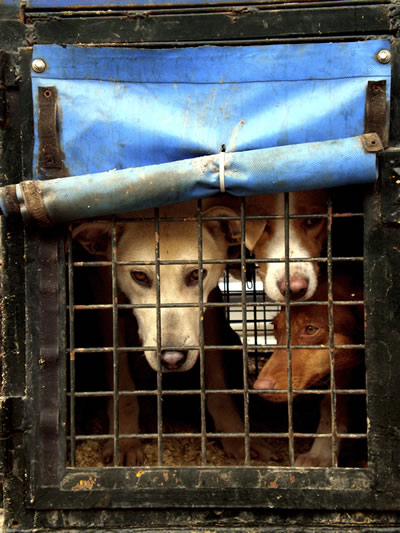Mission creep: Dog rescues and animal shelters risk public health and safety
Escalating dog bites and illness in adopted pets signal shift in dog rescue and animal shelter adoption policies
By: Patti Strand Date: 07/30/2014 Category: | Rescue |
There was a time – and it wasn’t that long ago – when humane societies and rescue groups were held in high regard. Animal welfare advocates and the public recognized their work as necessary and valuable, generally accepted their practices as appropriate and forgave their shortcomings because they were “doing God’s work.”
But that era may be drawing to a close, as a new ideology and the end of dog overpopulation in many parts of the country lead some not-for-profit humane organizations to abandon their missions and replace long-standing codes-of-conduct with irresponsible practices like:
- placing dangerous dogs with the public;
- placing pets without screening adopters;
- placing sick dogs; and
- participating in unregulated dog trafficking, the practice of moving literally thousands of dogs from high supply areas to areas that have solved or nearly solved their surplus dog problems.
Several trends have coalesced to cause this perversion of traditional rescue and sheltering, especially:
- nearly universal pet sterilization and the associated decline in available puppies;
- social pressure to adopt a shelter pet rather than buy a puppy from a breeder; and
- defamation campaigns waged against breeders and pet stores.
This monumental – but largely unrecognized – ideological shift allows irresponsible groups to hide behind their charity image and operate as unregulated wholesale and retail pet marketers who exploit public concern for animal welfare while endangering public health and safety.
Saving lives or endangering lives?
 According to records kept by Merritt Clifton of Animals 24-7 “ ...thirty-five shelter dogs … have participated in killing people since 2010." According to records kept by Merritt Clifton of Animals 24-7 “ ...thirty-five shelter dogs … have participated in killing people since 2010." |
For some shelters, saving a dog’s life has become a bigger priority than protecting the public from sick and dangerous dogs. Whether they misapply the no-kill shelter philosophy, try to achieve ever higher live-release rates, or are simply ignorant about dog behavior, a growing number of these shelters place dangerous dogs with adopters.
In previous decades, shelter workers designated dogs with serious bite histories as too dangerous for public placement and scheduled them for euthanasia. Today, that decision is by no means certain.
 |
A recent case in Stamford, Connecticut, a city that just fired their shelter director for placing known biters, highlights the risk. According to Connecticut News 12 reports, “Dogs described as ‘harmless’ in advertisements were often returned for biting people. Hollywood [the shelter director] then allegedly falsified documents, allowing dogs with a history of biting to be readopted. The dogs then bit their new owners.”
Unfortunately, the Stamford case is just the latest in a growing number of eerily similar situations where poor judgment and a lack of reasonable policies came together to injure or kill a member of the public. In 2003 in Newark, New Jersey, the Associated Humane Societies placed a dog that attacked and killed his new owner just 10 days after she adopted him. Investigations found that the dog had viciously attacked his previous owner and was surrendered to the shelter for euthanasia by the victim’s son. The son explained the dog’s serious bite history, signed the forms and paid the euthanasia fee to the shelter. Subsequently, the shelter discarded its pledge to euthanize the dog and placed him with an elderly woman instead. Perhaps they decided that the previous owner had misjudged the dog or that the vicious attack described by the victim’s son would not be predictive of the dog’s future behavior. Actually, however, past behavior remains the single best predictor of future behavior.
Merritt Clifton, the editor of Animals 24-7 has monitored and logged severe and fatal dog attacks since 1982. His records shine a bright light on this disturbing trend. He reports that between 1982 and 2002 there were only four severe attacks by shelter dogs and only two that were fatal. By 2010 he reports that fatal or disfiguring attacks had soared to 18, by 2013 they shot up to 27 and in just the first half of 2014 they already total 34. His records show that “thirty-five shelter dogs … have participated in killing people since 2010.” For more detail on this subject, read Clifton’s excellent article.
Saving lives or trading lives? The net effect of dog trafficking
Mission creep by irresponsible shelter and rescue management also fuels dog trafficking, the massive and growing movement of rescue dogs from areas of high supply to areas where there are fewer dogs available to meet demand. Dog trafficking creates new problems for destination communities and does nothing to solve surplus and stray dog problems in the source communities. It revitalizes and fuels the development of retail shelters and cynically passes the buck - from source communities that do little or nothing to deal with stray dogs and unwanted litters to receiving communities that have already spent tax dollars to contain or solve their own unwanted dog problems.
 Dog trafficking doesn't improve conditions in areas still suffering from surplus dog problems. Dog trafficking doesn't improve conditions in areas still suffering from surplus dog problems. |
Dog trafficking converts participating animal shelters and rescues into unregulated pet stores in a totally unregulated chain of supply that moves dogs from as far away as Mexico and Puerto Rico into US shelters and rescues. Some northern shelters now import thousands of dogs each year, flooding the local pet marketplace with out-of-area dogs, and causing nearby shelters to euthanize local dogs. Many of these groups host adoption events in parking lots and other public places within hours or a few days of the dogs’ arrival, leaving no time for evaluating each dog’s health and temperament or screening the adoptive families.
Shamefully, many of these retail shelters also reject local pets in need in order to grab more attractive ones from outside their state or region. Simultaneously they often disparage local animal control agencies as “kill shelters” to give themselves a marketing advantage.
Saving lives or spreading disease?
 Irresponsible rescue introduces disease and parasites through dog trafficking practices. Irresponsible rescue introduces disease and parasites through dog trafficking practices. |
But the problem doesn’t end with the lack of accountability within the shelter-rescue continuum. The practice also threatens public health and facilitates pet theft and cruelty to animals. Authorities have found rabid dogs and stolen dogs in this unregulated adoption channel along with some of the most inhumane source conditions you’ll find anywhere.
Dogs transported en masse from the southern to northern states and those entering the US from foreign countries often carry diseases and parasites to regions where they did not exist formerly, or where they have been eradicated or controlled.
Saving lives or eliminating competition?
Currently, a conspiracy of like-minded retail shelters and rescues who’ve had success in the commercial pet marketplace are working to destroy their competition (i.e., the pet stores that are honest enough to admit that they are pet stores). Unfortunately, they have duped many local governments into adopting their cause.
Amazingly, political leaders in Chicago and San Diego, to name a few cities, have been enticed into passing laws that force legal and heavily regulated businesses that pay taxes (i.e., pet stores) to convert their operations into this unregulated, unwarranted, out-of-control model. Claiming a moral high ground aimed at closing so-called “puppy mills,” these groups cynically scam governments into mandating that regulated pet store businesses sell only animals acquired from shelters and rescue groups.
The good news
But there is a light at the end of this tunnel. Finally, mainstream shelters and rescues are speaking out against the irresponsible actors and unprofessional practices in their industry. In an article he titled, Think globally, rescue locally: Rescue transports – a symptom of dysfunctional shelters and rescues, Mike Fry of the Animal Ark shelter in Minnesota lays it out. Challenging the very premise of rescue transports saving lives, he points out that the thousands of out-of-state dogs transported into Minnesota every year result in native Minnesota dogs being killed.
Responding to concerns of veterinarians and dog owners, state governments are also looking at the influx of imported dogs and responding to the challenge with regulations requiring health examinations of dogs and registration or licensing of rescue groups that import them.
And more good news: NAIA has assembled a legal team to address some of these issues proactively. Please contact us for more information at legalteam@naiaonline.org and sign up for alerts at NAIA Trust’s legislative lobby center at: http://cqrcengage.com/naiatrust/app/register?2&m=8478
About The Author
All Authors Of This Article: | Patti Strand |










